Page 22 of 392
Downloaded from www.Manualslib.com manuals search engine -
or the instrument panel ... or the safety belts!
With safety belts, you slow down
as the vehicle does.
You get more time to stop. You stop over more distance,
and your strongest bones take the forces. That’s why safety belts make such
good sense.
1-10
Page 31 of 392
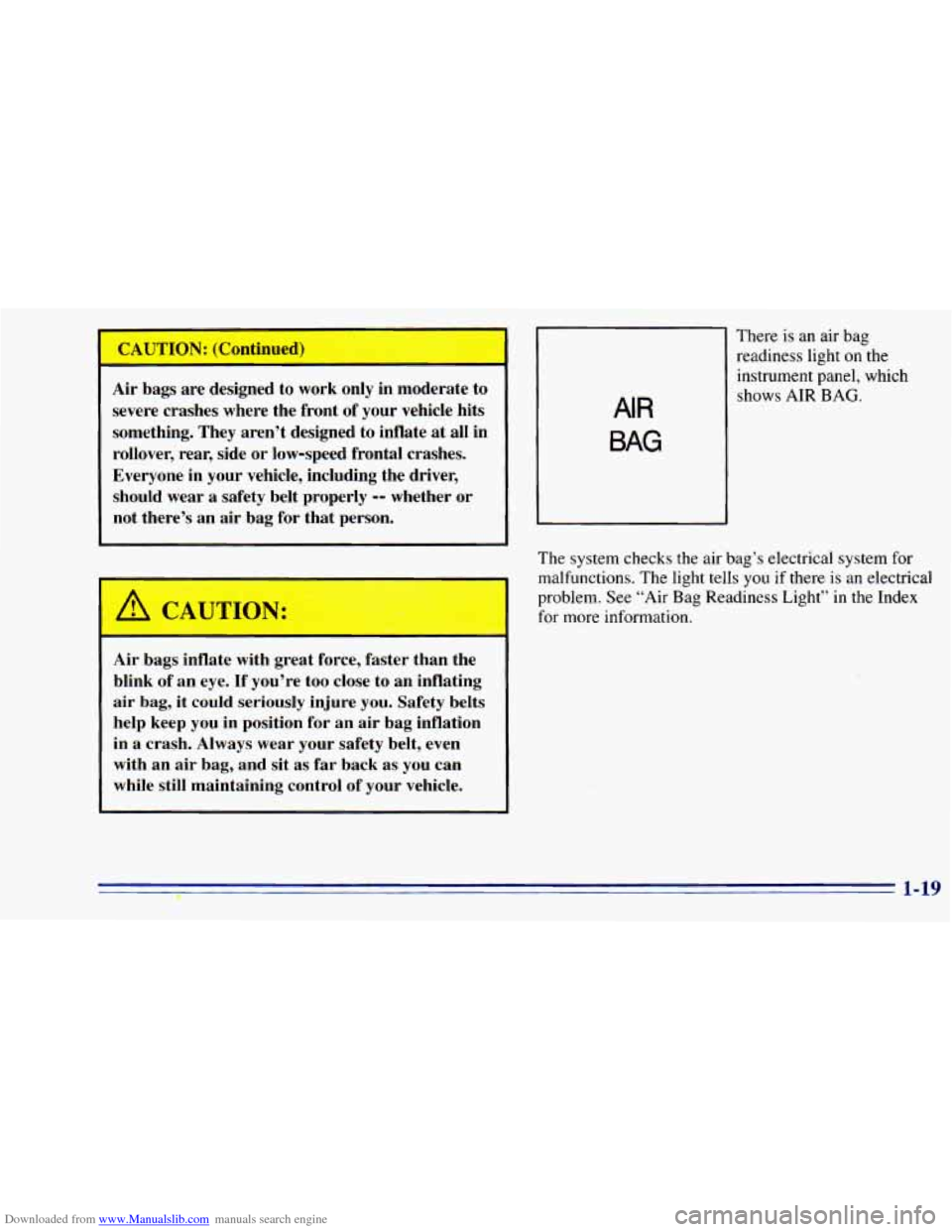
Downloaded from www.Manualslib.com manuals search engine CAUTION: (Continued)
Air bags are designed to work only in moderate to
severe crashes where the front of your vehicle hits
something. They aren’t designed to inflate
at all in
rollover, rear, side or low-speed frontal crashes.
Everyone in your vehicle, including the driver,
should wear
a safety belt properly -- whether or
not there’s an air bag for that person.
Air bags inflate with great force, faster than the
blink
of an eye. If, you’re too close to an inflating
air bag, it could seriously injure you. Safety belts
help keep you in position for an air bag inflation
in
a crash. Always wear your safety belt, even
with an air bag, and sit as far back as you can
~ while still maintaining control of your vehicle.
AIR
BAG
There is an air bag
readiness light on
the
instrument panel, which
shows
AIR BAG.
The system checks the air bag’s electrical system for
malfunctions. The light tells you
if there is an electrical
problem. See “Air Bag Readiness Light’’
in the Index
for more information.
(L 1-19
Page 59 of 392
Downloaded from www.Manualslib.com manuals search engine Section 2 Features and Controls
1
I
Here you can learn about the many standard and
optional features
on your vehicle, and information on
starting, shifting and braking. Also explained are the
instrument panel and the warning systems that
tell you if
everything
is working properly -- and what to do if you
have
a problem.
Keys
A CAUTION:
!n in a VI !W the
Lea lg youni
ignition key is dangerous for many reasons.
A child
or others could be badly injured or even killed.
They could operate power windows
or other
controls or even make the vehicle move. Don't
leave the keys in
a vehicle with young children.
2- 1
Page 65 of 392
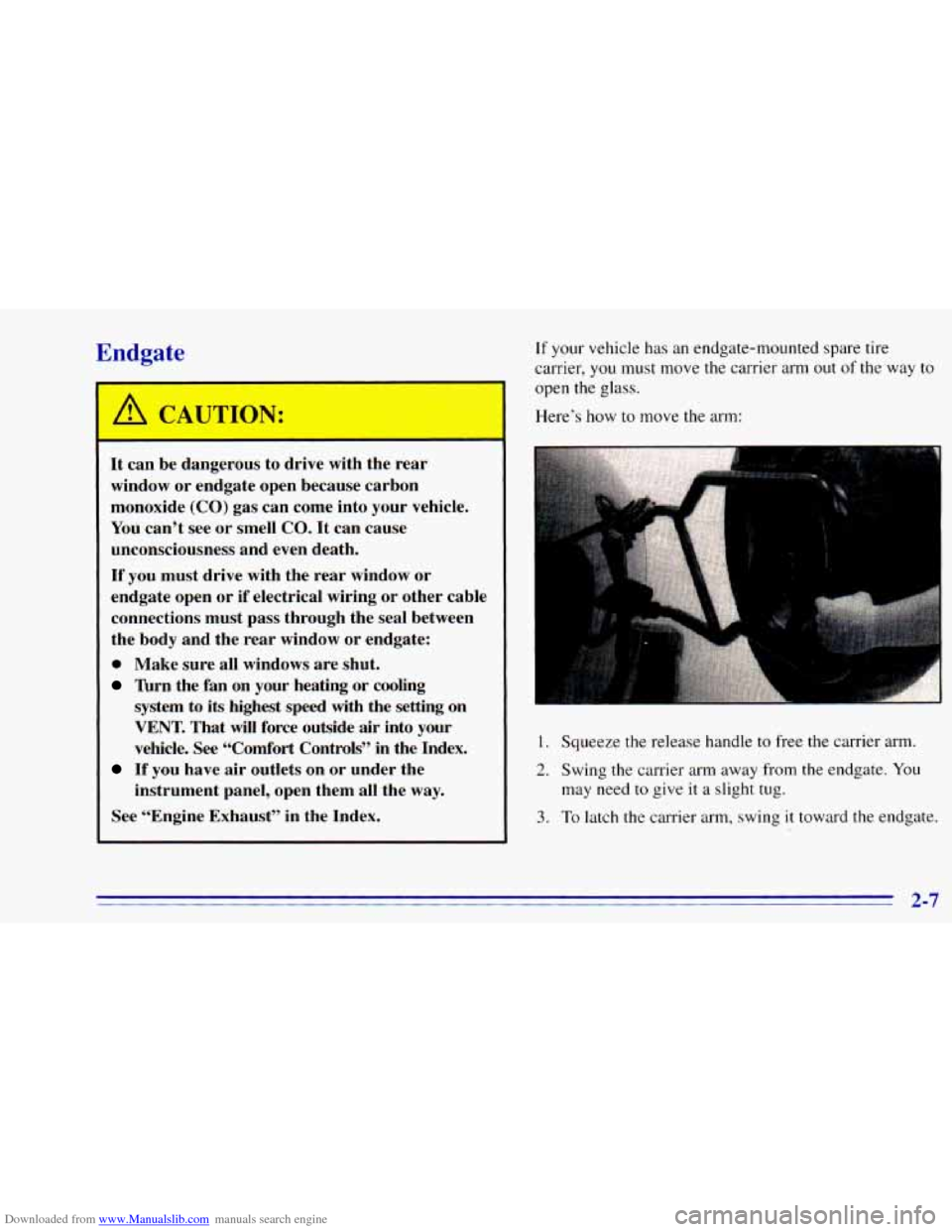
Downloaded from www.Manualslib.com manuals search engine Endgate
A CAUTION:
It can be dangerous to drive with the rear
window or endgate open because carbon
monoxide (CO) gas can come into your vehicle.
You can’t see or smell CO. It can cause
unconsciousness and even death.
If you must drive with the rear window or
endgate open or if electrical wiring or other cable
connections must pass through the seal between
the body and the rear window or endgate:
0 Make sure all windows are shut.
’hrn the fan on your heating or cooling
system to its highest speed with the setting on
VENT. That will force outside air into your
vehicle.
See “Comfort Controls” in the Index.
instrument panel, open them all the way.
If you have air outlets on or under the
See “Engine Exhaust” in the Index.
If your vehicle has an endgate-mounted spare tire
carrier,
you must move the carrier arm out of the way to
open the glass.
Here’s how to move the arm:
1. Squeeze the release handle to free the carrier arm.
2. Swing the carrier arm away from the endgate. You
3. To latch the carrier arm, swing it toward the endgate.
may need
to give it a slight
tug.
Page 81 of 392
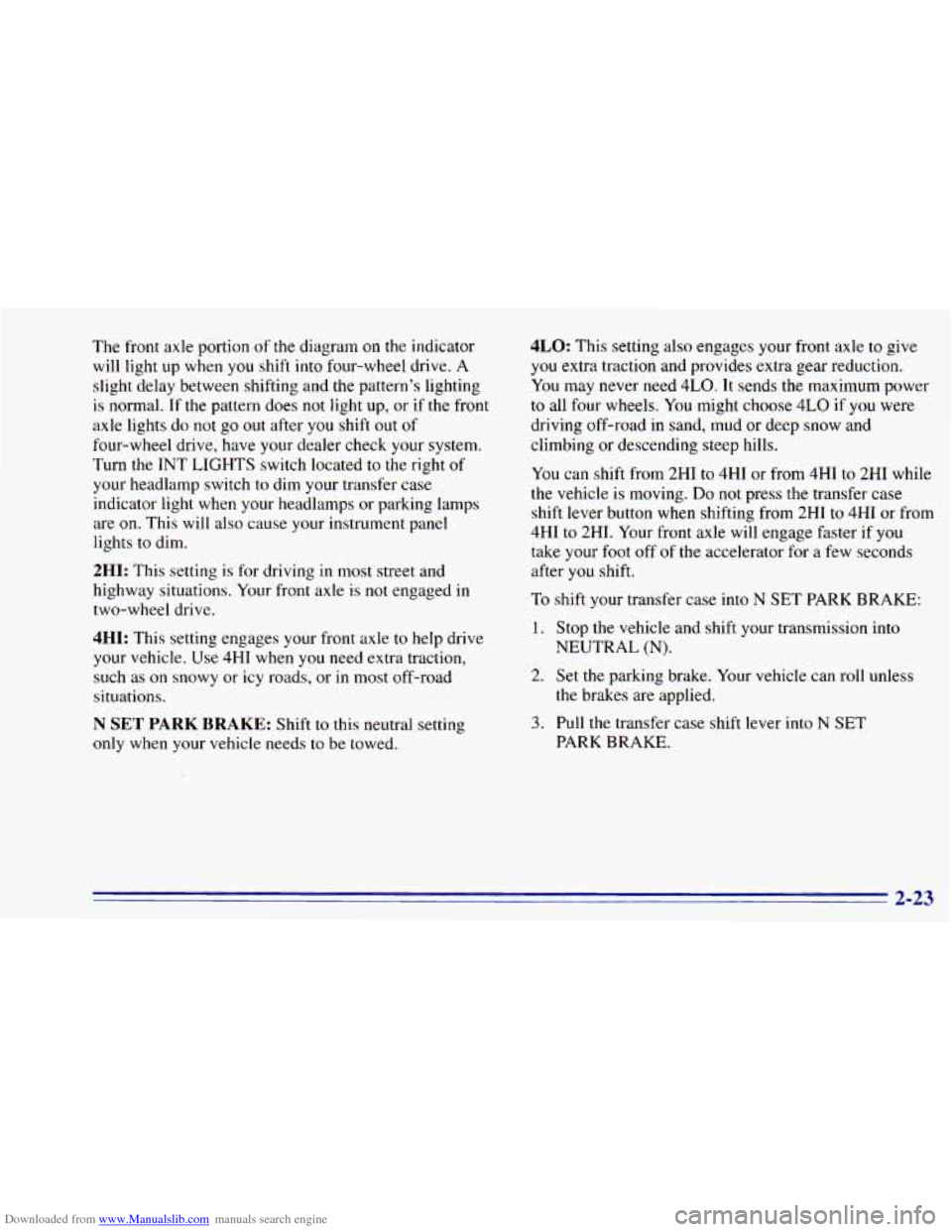
Downloaded from www.Manualslib.com manuals search engine The front axle portion of the diagram on the indicator
will light up when
you shift into four-wheel drive. A
slight delay between shifting and the pattern’s lighting
is normal. If the pattern does
not light up, or if the front
axle lights do not go out after
you shift out of
four-wheel drive, have your dealer check your system.
Turn the INT LIGHTS switch located to the right of
your headlamp switch to dim your transfer case
indicator light when your headlamps or parking lamps
are
on. This will also cause your instrument panel
lights
to dim.
2HI: This setting is for driving in most street and
highway situations. Your front axle is
not engaged in
two-wheel drive.
4HI: This setting engages your front axle to help drive
your vehicle. Use 4HI when you need extra traction,
such as on snowy or icy roads, or in most off-road
situations.
N SET PARK BRAKE: Shift to this neutral setting
only when your vehicle needs
to be towed.
4LO: This setting also engages your front axle to give
you extra traction and provides extra gear reduction.
You may never need 4LO. It sends the maximum power
to all four wheels. You might choose 4LO if you were
driving off-road in sand, mud or deep snow and
climbing
or descending steep hills.
You can shift from 2HI to 4HI or from 4HI to 2HI while
the vehicle
is moving. Do not press the transfer case
shift lever button when shifting from 2HI to 4HI or from
4HI
to 2HI. Your front axle will engage faster if you
take your foot off of the accelerator for a few seconds
after
you shift.
To shift your transfer case into N SET PARK BRAKE:
1. Stop the vehicle and shift your transmission into
NEUTRAL
(N).
2. Set the parking brake. Your vehicle can roll unless
3. Pull the transfer case shift lever into N SET
the brakes are applied.
PARK BRAKE.
2-23
Page 85 of 392
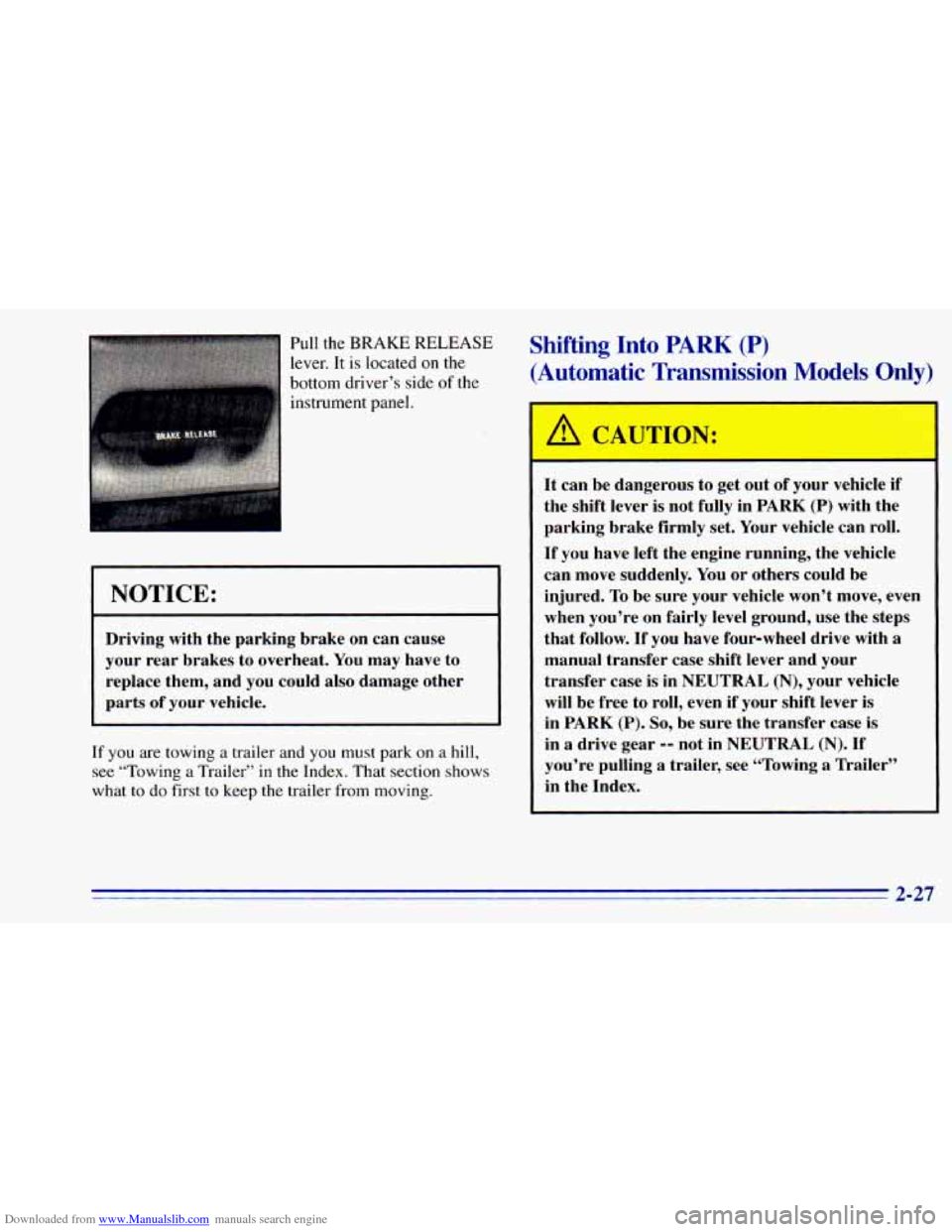
Downloaded from www.Manualslib.com manuals search engine Pull the BRAKE RELEASE
lever. It is located
on the
bottom driver’s side
of the
instrument panel.
Shifting Into PARK (P)
(Automatic Transmission Models Only)
NOTICE:
Driving with the parking brake on can cause
your rear brakes to overheat. You may have to
replace them, and you could also damage other
parts of your. vehicle.
If
you are towing a trailer and you must park on a hill,
see “Towing a Trailer’’ in the Index. That section shows
what
to do first to keep the trailer from moving.
A CAUTION:
It can be dangerous to get obL df your vehicle if
the shift lever is not fully in
PARK (P) with the
parking brake firmly set. Your vehicle can roll.
If you have left the engine running, the vehicle
can move suddenly. You or others could be
injured. To be sure your vehicle won’t move, even
when you’re on fairly level ground, use the steps
that follow. If you have four-wheel drive with
a
manual transfer case shift lever and your
transfer case is in
NEUTRAL (N), your vehicle
will be free to roll, even if your shift lever is
in
PARK (P). So, be sure the transfer case is
in a drive gear -- not in NEUTRAL (N). If
you’re pulling a trailer, see “Towing
a Trailer”
in the Index.
2-27
Page 94 of 392
Downloaded from www.Manualslib.com manuals search engine Turn SignaVMultifunction Lever
The lever on the left side of the steering column
includes your:
0 Turn Signal and Lane Change Indicator
0 Headlamp HighLow Beam Changer
0 Windshield Wipers
0 Windshield Washer
0 Cruise Control (Option)
Turn and Lane Change Signals
The turn signal has two upward (for right) and two
downward (for left) positions. These positions allow
you
to signal a turn or a lane change.
To signal a turn, move the lever all the way up or
down. When the turn is finished, the lever will
return automatically.
An arrow on the instrument
panel will flash in the
direction
of the turn or
lane change.
To signal a lane change, just raise or lower the lever
until the arrow starts
to flash. Hold it there until you
complete your lane change. The lever will return by
itself when
you release it.
2-36
Page 95 of 392
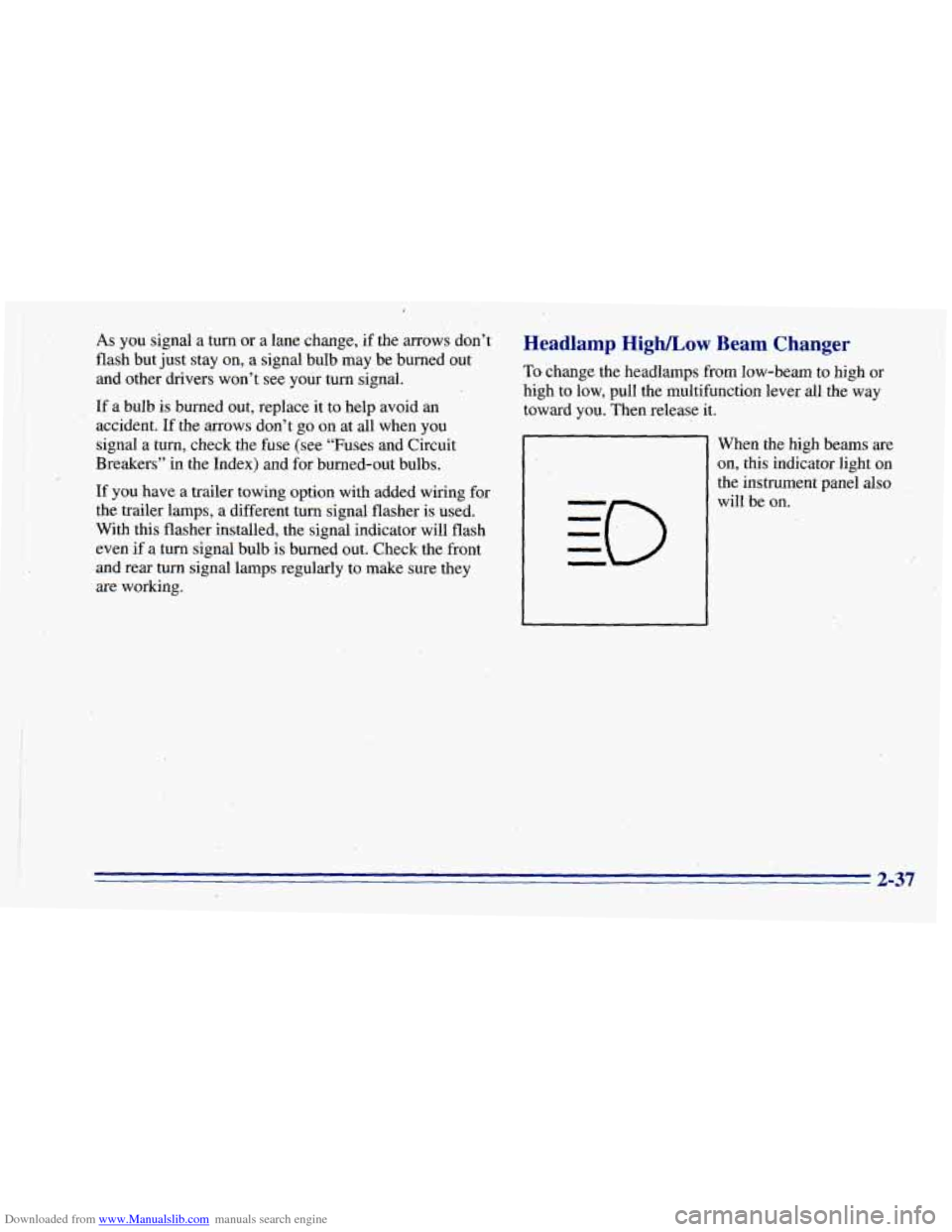
Downloaded from www.Manualslib.com manuals search engine ,
As you signal a turn or a’lane change, if the arrows don’t
flash but just stay on, a signal bulb may be burned out
and other drivers won’t see your turn signal.
accident. If the arrows
don’t go on at all when you
signal a turn, check the fuse (see “Fuses and Circuit
Breakers” in the Index) and for burned-out bulbs.
If you have a trailer towing option with added wiring for
the trailer lamps, a different turn signal flasher is used.
With this flasher installed, the signal indicator will flash
even if a turn signal bulb is burned out. Check the front
and rear turn signal lamps regularly
to make sure they
are working.
,- If a bulb is burned out, replace it to help avoid an
Headlamp High/Low Beam Changer
Toxhange the headlamps from low-beam to high or
high to low, pull the multifunction lever all the
way
toward you. Then release it.
When the high beams are
on, this indicator light on
the instrument panel also
will be
on.
2-37